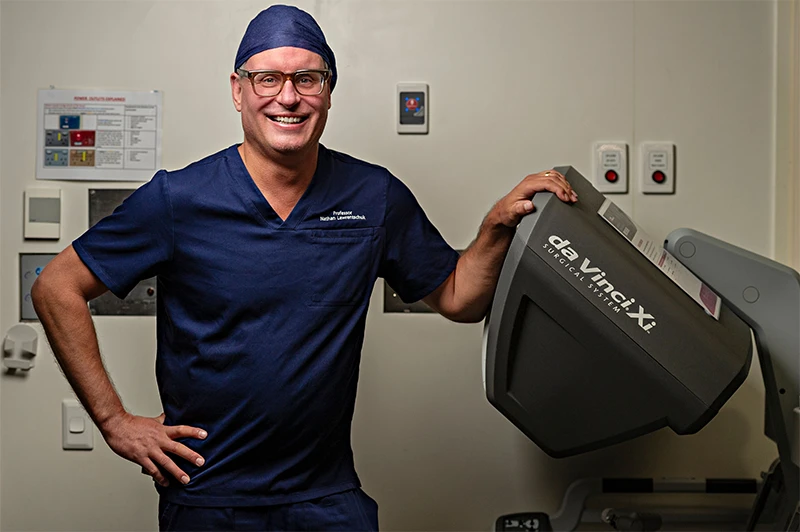A Robotic Assisted Cystectomy / Cystoprostatectomy is a major surgical procedure in which the entire bladder is removed. This operation is most commonly performed to treat invasive or high-grade bladder cancer that cannot be managed with more conservative treatments.
What does ‘robotic’ mean?
Prof Lawrentschuk performs this surgery using the da Vinci robotic system, which provides enhanced precision, visual clarity, and control. It is important to note that the robotic system does not operate autonomously; all movements are directed entirely by Prof Lawrentschuk from a console.
Once the bladder is removed, a new way for urine to exit the body must be created. This is usually achieved using a segment of bowel, forming either an external stoma (ileal conduit) or an internal reservoir (neobladder).
Why is an cystectomy required?
Radical cystectomy is generally recommended to manage aggressive, life-threatening bladder cancer. In select cases, it may also be used to treat non-cancerous but debilitating conditions, such as severe interstitial cystitis or bladder damage following radiotherapy.
Before surgery
You will be contacted 1–2 weeks prior to your scheduled procedure with specific fasting instructions and hospital admission details. You will also receive a link to complete your online admission forms.
It is important to advise the rooms if you are taking any blood thinners or any prescribed medications for diabetes or weight loss purposes. The rooms can be contacted on 9329 1197
During surgery
The procedure is performed under general anaesthetic. To create working space inside the abdomen, carbon dioxide gas is introduced to inflate the abdominal cavity. Surgery is carried out through six small incisions in the abdomen using minimally invasive techniques.
Structures removed can include:
- The entire bladder
- In men: the prostate gland and seminal vesicles (cystoprostatectomy)
- In women: the uterus, fallopian tubes and ovaries
- Occasionally, the urethra
- Regional lymph nodes if the operation is for cancer
Depending on what you have discussed, Prof Lawrentschuk will either create an ileal conduit or a neobladder. This is where segment of small bowel is reshaped into a urine-holding reservoir, allowing urine to pass through the urethra in a more natural manner.
Following surgery
Hospital stay
You will be admitted on the day of your surgery, with a typical hospital stay lasting 3-5 nights. Post-operatively, patients may spend the first night or longer in the Intensive Care Unit (ICU). Please note that:
- Normal eating is usually delayed for several days due to bowel inactivity (ileus), which can take up to a week to resolve.
- If you have an ileal conduit, you will be taught by nurses how to manage your stoma before going home.
- If you have a neobladder, you or your carer will be trained to flush the bladder using sterile water via the catheter. The catheters are removed approximately 3–4 weeks after surgery.
Recovering at home
Once at home, please note the following:
- Swelling of the penis and scrotum is common in men and may take several weeks to resolve
- Driving should be avoided for 4–6 weeks
- Returning to work is not recommended for at least 6 weeks
- Vigorous exercise or heavy lifting should be avoided for 6–8 weeks
- Fatigue is common - it may take 3–6 months to regain normal energy levels
Possible side effects
Very common
- Infertility in men, due to removal of the prostate and seminal vesicles (cystoprostatectomy)
- Erectile dysfunction in men, due to possible nerve damage during surgery
- Infertility in women, particularly if the uterus, ovaries, or fallopian tubes are removed
- Shortening of the vagina in women, which may cause discomfort or difficulty with sexual intercourse
Common (1 in 2 to 1 in 10)
- Cancer recurrence, dependent on pathology results
- Incidental discovery of prostate cancer requiring further management
- Ureteric strictures (scarring at the bowel join), possibly needing further intervention
- Recurrent urinary tract infections
- Kidney stones
- Deterioration of kidney function, potentially leading to dialysis
Occasional (1 in 10 to 1 in 50)
- Leg swelling (lymphoedema)
- Adhesions causing bowel obstruction, which may require additional surgery
When to seek help
Please contact Professor Lawrentschuk’s rooms at 9329 1197 or attend your nearest Emergency Department if you experience:
- Signs of infection, including fever, chills and dark, cloudy urine.
- Long-lasting nausea and vomiting.
- Increasing discolouration, swelling, pain or pus from your surgical sites.
- Black, brown or dark purple skin discolouration of your stoma.
- Excessive pain that you can’t control with your prescribed medications.
- Inability to urinate or difficulty urinating
Follow-up and monitoring
A follow-up appointment will be scheduled 6-8 weeks post-surgery to:
- Review your recovery
- Discuss histopathology results of the removed tissue
Pathology results are typically available within 10–14 days. In some cases, your results may be reviewed in a
multidisciplinary team meeting to determine the most effective next steps. If this occurs, you will be notified
and kept informed of the team’s recommendations.
If you have any queries, please use the contact details below:
MONDAY to FRDAY 8:30AM–4:00PM
Call the rooms at 9329 1197
AFTER HOURS
Contact Epworth Emergency on 03 9426 6666 or Royal Melbourne Emergency on 03 9342 7000.
You can also page Prof Lawrentschuk on 03 9387 1000.
For appointments and enquiries:
CONSULTING LOCATIONS


